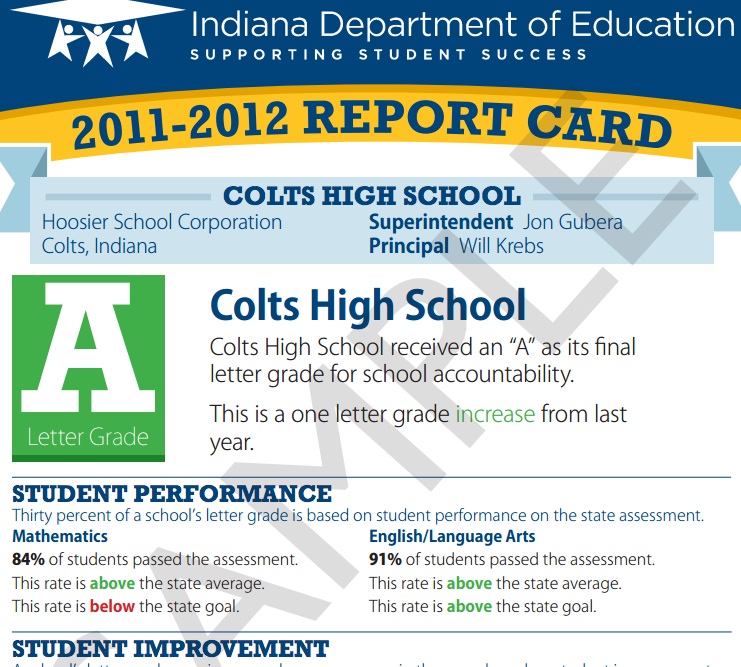Why State Lawmakers Threw Out The Brand-New A-F School Rating System

Elle Moxley / StateImpact Indiana
Kalen Phillips, left, and Cole Crouch, both students in the AP Statistics class at Ben Davis High School in Indianapolis, listen to a presentation from StateImpact Indiana's Kyle Stokes on the system state officials use to issue letter grade ratings to schools.
If at first you don’t succeed, just undertake a massive re-write of the state’s A-F rating system for schools again?
That’s the order state lawmakers have given education officials barely a year after the State Board of Education approved a complex formula for formally identifying Indiana’s best- and worst-performing schools.
Officials won’t have to start from scratch. The Indiana General Assembly’s order still requires state officials to blend schools’ pass-fail rates on statewide tests (as they have since 1999) with a measure of students’ relative academic “growth” (as last year’s re-write prescribed) in the re-written school letter grading system.
But in passing House Enrolled Act 1427, lawmakers took aim at the method state officials chose to measure student growth — a method critics charge is so complicated that even state superintendent Glenda Ritz cannot advise local educators how to improve their final rating.
- In Tackling Indiana's Complex 'Growth Model,' High School Students Enter Complex Political FrayAmong the groups hoping to add their input during the state’s re-write of the A-F school rating system: an AP statistics class at Ben Davis High School in Indianapolis. They asked StateImpact Indiana‘s Kyle Stokes to help them study the “growth model.”Download

Elle Moxley / StateImpact Indiana
StateImpact Indiana's Kyle Stokes speaks to AP Statistics students at Ben Davis High School.
—Kalen Phillips, Ben Davis High School student
“I cannot tell any school what their grade represents,” Ritz said at the State Board’s April meeting. “It lacks transparency. School districts are wondering how it is that they’re supposed to improve and get to the next letter grade — what does that represent?”
General Assembly members agreed, telling state officials to find another growth metric and re-write the grading system around that metric by November.
“The legislature has stepped in to try to provide some guidance and leadership on that,” says Sen. Luke Kenley, R-Noblesville, who was among the lawmakers advocating the change.
But some members of the State Board — a gubernatorially-appointed executive panel that oversees the Indiana Department of Education — dispute Kenley’s charge. Other board members call the General Assembly’s action unnecessary and premature.
“For the legislators to think we just fell off the pumpkin truck, if you will, that we need to be told we need to review A-F, I think is really presumptuous,” board member Jo Blacketor told StateImpact. “We were headed in that direction anyway,” saying the State Board viewed the grades as a “work in progress.”
The ‘Growth’ Part Of The Growth Model
The first step for state officials in determining a letter grade for an elementary and middle school is to determine the percentage of students at the school who passed statewide tests. If between 80 and 90 percent of a school’s students pass the ISTEP, for instance, the school’s “base” grade is a B.But as we’ve explained before, the next step of the process can change that grade. State officials then examine how the students in the school performed relative to their statewide peers on the test.
Students who scored significantly lower on the ISTEP this year than students statewide who scored similarly on last year‘s test can be counted as “low growth.”
Conversely, students who scored significantly higher this year than students who scored similarly on last year’s test can be counted as “high growth.”
A high number of “high growth” students can bump up a school’s letter grade, while too many “low growth” students can hurt a school’s letter grade.
Beating Heart? Black Box?
While the growth measures are designed to make sure schools focus on improving every student’s test score, the metrics’ have provided fuel for the critics of the A-F model across the ideological spectrum.
Some have charged the growth measures are a black box at the school letter grading system’s heart. Others, such as Sen. Luke Kenley, say state education officials’ inability to explain the growth measures have made it hard to make sense of the ratings the model results.

Kyle Stokes / StateImpact Indiana
Former state superintendent Tony Bennett, left, leads a meeting of the Indiana State Board of Education on February 8, 2012, during which members approved the A-F re-write that lawmakers essentially threw out during their 2013 session.
“I don’t mind it being complex in the detail, but whoever your audience is needs to understand what the result is,” Kenley says.
State Board member Neil Pickett says he rejects the idea the model is difficult to understand.
“Sure, under the hood, the actual calculations of the growth rates are probably fairly complex,” board member Neil Pickett said at the April meeting, but “the actual results, as reported on the very simple forms designed by DOE, are very clear and very straightforward.”
Pickett doesn’t speak for every member of the State Board. Blacketor says she too thinks the growth measures are too complex, but says she feels as though state lawmakers have overstepped their bounds in calling for a re-write.
“I’m sad that legislators feel like they have to run the Department of Education,” Blacketor said.
There are signs the legislative branch is equally unhappy. During debate on the floor of the Indiana House, Rep. Kreg Battles, D-Vincennes, said he would be voting against the re-write bill — and not because he was a big fan of the A-F model.
“We’re gonna trust the State Board to come up with this magic formula remembering it was the State Board that created the formula that most of us in this room think is pretty daggone flawed,” Battles said.
Podcast: Play in new window | Download

